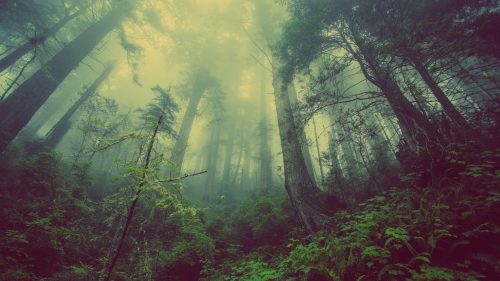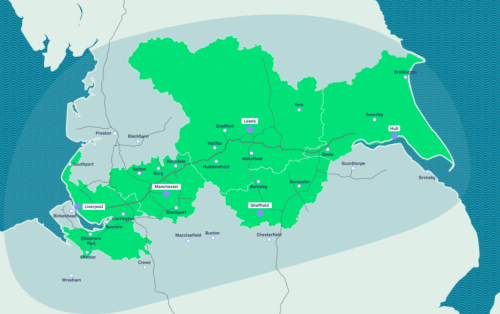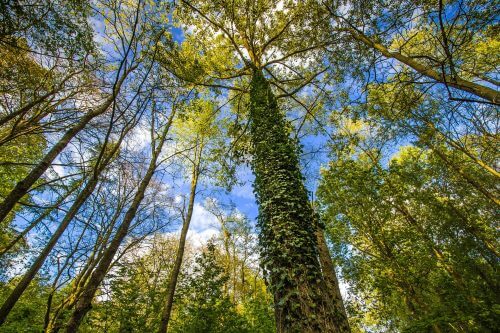The purpose of the "Northern Forest" is to fight climate change and help the environment. The Chinese, Indians and Canadians also go with Ron in their hearts and hands and plant millions of trees - should Israel also join in the celebration?

By Ran Ben Michael, Angle, Science and Environment News Agency
At the beginning of 2018, the British government announced the creation of a new forest: the "Northern Forest". The British decided to plant about 50 million trees at a total cost of half a billion pounds to create a green strip that is about 200 kilometers long from Liverpool and Manchester in the west through Leeds and Sheffield to the city of Hull on the east coast of the island.
Why does Britain even need a new forest? We are used to thinking of the color green as the main characteristic of the traditional English landscape picture: from the green hills of the countryside to the thick Sherwood forest, where Robin Hood finds hiding. However, today the origin of the shades of green in England is mainly from agricultural crops and low plants and not from the foliage of broad-leaved trees.
where are all the trees
The British Isles are an excellent place for trees to grow: the seasonality, rainfall, soil and topography all work in their favour. In the distant past, the tree cover was extensive, but exploitation and clearing for other land uses such as agriculture and grazing led to a significant decrease in the cover to only a quarter of the land area as early as the first century AD. After the First World War, the cover decreased further to only 5 percent due to overexploitation of the trees. Following this, the National Forestry Committee was established in 1919 to manage this natural resource. Today, the coverage rate is about 13 percent in the United Kingdom as a whole. However, UK forest cover still falls short of the European average, which hovers around 30 per cent and is a far cry from that of Finland, for example, where almost 75 per cent of its land is forested.
In the part where the new giant forest will be established, there was traditionally more heavy industry. Therefore, the tree cover there today stands at less than 8 percent and the addition of a mosaic of forest units over 250 square kilometers by 2050 will significantly change the surface.
adapt to climate change
Forests and trees are key players in the fight against climate change and adaptation efforts. They have many benefits in the field of health and recreation in both urban and rural areas such as reducing noise, absorbing pollutants and providing a green landscape that positively affects physical health, mental state and learning and concentration abilities . Trees also have a restorative value in restoring biodiversity and preventing soil erosion or flooding. An economic assessment of US forests by the International Nature Conservancy TNC It is worth about 1,000 dollars per dunam per year.
Indeed, the British government has announced that it sees the new forestry move as a component of its support for local agriculture after the separation from the European bloc and also in its commitment to deal with global climate change. In fact, this is a component of the new environmental policy plan of the Conservative government in Great Britain, which included, among other things, the establishment of Governmental committee on the issue of natural capital which recommended the planting of an enormous amount of 625 million new trees, mainly on the edges of urban areas, which would yield an economic benefit to the extent of half a billion pounds per year.

This is not the first time that a project of this type has been carried out in England: in 1991 the cultivation of the national forest was announced (The National Forest), an area of about 500 square kilometers near the cities of Derby and Nottingham, an area where the forest cover was lower than average - only 6 percent. So far, more than 8.5 million trees have been planted in the national forest to restore the damaged landscape, mainly due to mining activity. The national forest, which continues to grow at a modest rate of about 2.5 square kilometers every year, is considered a success story mainly due to the strictness of combining nature conservation and the use of local species alongside fruitful work with the private landowners in the area, who own most of the land (this is in contrast to our situation, where most The land in general - and the forests in particular - is actually in the hands of the state or the National Fund for Israel).
Did you hit - did you plant?
Although there is Evaluations Because the northern forest has an economic potential of more than 2 billion pounds from sources such as domestic tourism and the increase in real estate values, together with about 2.5 billion pounds in ecological services (such as carbon sequestration and protection of 190 thousand homes from flooding), in the United Kingdom there is already a non- Little criticism of the plans to plant the new forest. There are those who criticize the decision to finance part of the project through the budgets of large public works projects, such as the new high-speed rail line between Birmingham and London, which also include components of financing compensation for damage to the ecosystem, for example through the planting of new forests, because the rail project may destroy or damage In about 100 sites of a forest classified as ancient (meaning it has existed continuously since at least 1600).
A similar criticism is directed towards a global program of the United Nations called REDD+ The compensation for the loss of forest cover, because it does not prevent the destruction of tropical forests, mainly in South America while harming the local communities, by the mining companies and this only because they pay for afforestation in other places.
The Chinese and Indians can do more
The planting of the northern forest will begin this March. They may seem ambitious and extensive, but more is always possible. The Chinese government, for example, plans to plant trees in 2018 in an area of approximately 65 square kilometers, more than three times the size of the State of Israel. China's Forestry Administration seeks to increase forested area coverage from 21.7 percent today to more than 26 percent in 2030. This is an addition of 412 thousand square kilometers (a little less than the size of Sweden) with an investment of about 80 billion dollars.
Planting trees as a means to combat climate change is happening all over the world. Canada - another country that seems to us like an endless forest - wants to plant 3,000 square kilometers of native forest in British Columbia. Similar efforts are taking place in the rainforests of Brazil, Ecuador, Peru, Indonesia and other countries.
However, the world record for rapid tree planting belongs to Indians: in July 2017 1.5 million volunteers planted 66 million (!) trees in central India within 12 hours.

Mass plantings on a large scale are not a magic solution to environmental problems. Along with success stories, there are also glorious failures in this field. Thus, for example, between 1978 and 2014, the Chinese government tried to fight the expansion of the Gobi Desert by creating the "Great Green Wall of China", but the use of non-native species did not lead to the desired results, mainly because the plantings did not withstand the severe drought conditions in the region. An even more ambitious green forest wall began construction in 2007 in Africa as well and was planned over 7,700 kilometers crossing 11 countries to deal with the apparent expansion of the Sahara desert. However, after an investment of 4 billion dollars, the direction was changed to land and water use management that would produce more benefits for the local communities than forestry.
In general, strengthening an existing forest system will be more effective than creating a forest from scratch. Therefore preventing deforestation will be more effective than new plantings. This is especially true in places like California where wildfires occur - mostly unintentionally - due to the huge fires, which are developing and intensifying precisely because of the climate change that forestry seeks to deal with.
A tree for every two Israelis
And what about us? According to an article from 2105 in the journal Nature, in Israel there are two trees per person, like in the African Djibouti, this is compared to 47 trees per inhabitant in Great Britain, but this is not a show that is completely faithful to reality. Forestry is part of the intervention in Israel's natural resources and their management since the beginning of the British Mandate (it turns out that here we have preceded what is happening in the mother country). Today, the planted forest in Israel has almost nowhere to grow, and in addition to this, there is a debate - sometimes fierce and stormy - about whether large-scale plantings are suitable for the local climate and nature and whether it is necessary to go beyond the boundaries of the forested areas in a way that requires inputs of water, land and other changes in the ecosystem.
Prof. Avi Parvolotsky, former director of the Department of Natural Resources at the Volcanic Institute of the Ministry of Agriculture explains: "In Israel, afforestation efforts similar to those that have been going on around the world for about a hundred years have been undertaken. Many of them can be considered successful, partly because most of the trees are local species and the Israeli forest is undoubtedly a success story in the field of providing landscape and recreation services. Today, the portion of land use allocated to afforestation is almost completely exhausted and there is a dialogue about the tension between the continuation of afforestation, mainly in the south of the country, and the protection of nature and its character."
According to the data of the state of nature report of the weave, as of 2016 the tree cover in Israel is about 13.5 percent, of which 4 percent is planted forest and the rest Mediterranean woodland - natural or managed. Most of the forest is in the northern part of Israel, where the coverage is about 10 percent. It may be that our war on climate change needs to find other means for itself. Prof. Parvolotsky predicts that this is how things could develop: "KKL-Junk has a forest management plan based on ecological knowledge and it is hoped that it will be implemented so that the forest in Israel will indeed continue to provide benefits without harming those places that are sensitive to its continued expansion."

9 תגובות
Fill the Negev with trees wherever possible. Let's not forget that the pine trees and their cultivation is a dizzying success!!!
Like "monkey after man" the nations learn from the Israelites to plant and plant trees. But talk separately and actions separately, let's see if they will really be planted and how much?
To the author of the article:
You wrote "today the part of the land use allocated to forestry is almost completely exhausted". And I wondered: Really?!
Even today there are so many areas empty of trees throughout the country. Just for example, roadsides. There are many areas on the sides of roads that are not only empty of trees and bushes, but the state bothers to consistently spray them with herbicides. These killers kill thorns but also trees that grew by themselves from seeds.
If we collect all the areas on the sides of the roads that can be filled with trees, we will reach a lot of areas.
There are also many empty hills in the Galilee and in general, many areas empty of trees that can, and in my opinion, must be forested.
If every person and there are 7 billion will plant a tree then there will be 7 billion more trees
I wonder how many trees the lord of the circle planted, he actually excels at lighting racist, nationalist fires. And to the point. Go to the Gilboa / Yatir forests and much more. There were fires of this kind and others, most of them negligible, some of them indeed terrorist arson, but many, just glorious Jewish negligence. It is also worth visiting the Rihan forest or the forests between Nazareth and Deborah. In short, it is better to single out the hatred for Israel today and go out into the forest with a happy and good heart.
1]. Is it worthwhile and desirable to forest the Negev?
2]. Will afforestation of the Negev change the climate in the Negev to a more rainy climate?
3]. If the answer to 1 is yes/no, what are the reasons?
4]. If the answer to 2 is yes, will the result be increased settlement of the Negev?
All the trees that the Jews plant, the Arabs burn, a hundred years of planting, are burned in three days.
We planted millions of trees, the Arabs came and cut down wood for heating, Arab terrorists burn forests...
Israel is the only or one of the only countries that has more trees at the beginning of the 21st century than ash at the beginning of the 20th century. This is due to Kekel's activity and proactive tendency.